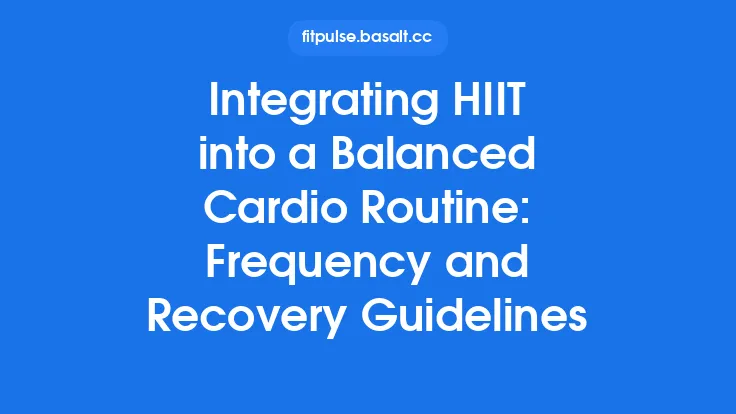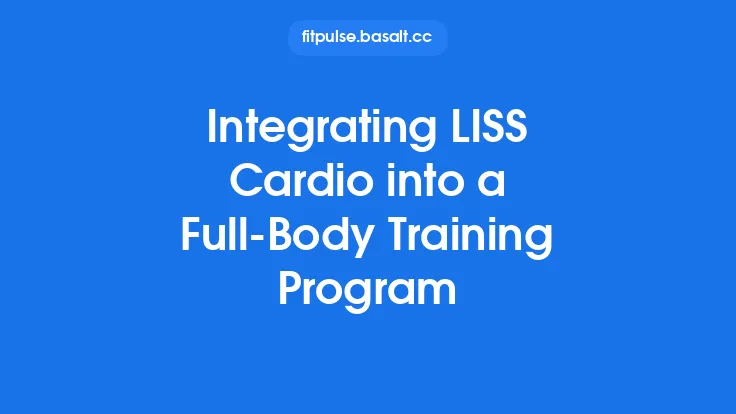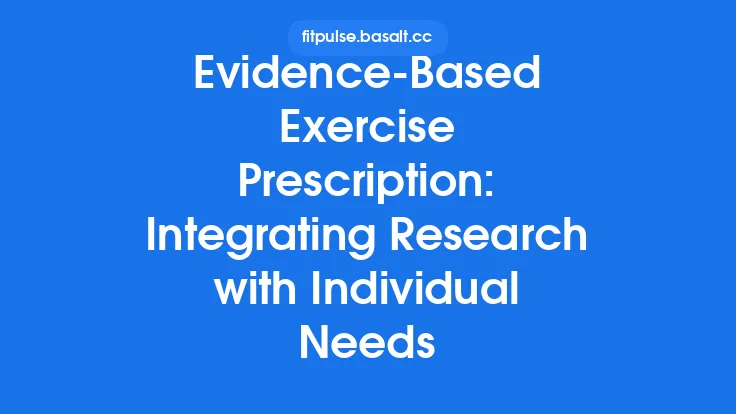Integrating virtual‑reality (VR) cardio experiences into a traditional exercise routine can feel like adding a new dimension to an already familiar workout landscape. While the core principles of cardiovascular training—progressive overload, consistency, and recovery—remain unchanged, VR introduces immersive environments, gamified feedback, and novel movement patterns that can enhance motivation, diversify stimulus, and even improve adherence. Below is a comprehensive guide to blending VR cardio sessions with conventional training, covering everything from program design and equipment considerations to practical tips for seamless integration.
Understanding the Complementary Roles of VR Cardio and Traditional Workouts
Traditional cardio typically involves steady‑state activities (running, cycling, rowing) performed on predictable equipment or outdoors. The focus is often on measurable outputs such as distance, speed, and heart‑rate zones.
VR cardio places the same physiological demand within a simulated environment—think sprinting through a futuristic city, boxing against holographic opponents, or paddling down a virtual river. The immersive visual and auditory cues can:
- Increase perceived enjoyment, which research consistently links to higher long‑term adherence.
- Provide variable terrain and pacing without the need for physical space or equipment changes.
- Offer instant, game‑style feedback (e.g., points, levels) that can serve as an additional motivational cue.
When combined, these modalities can create a balanced program that leverages the structure of traditional training while injecting the novelty and engagement of VR.
Mapping VR Cardio Experiences to Established Training Zones
To keep the integration scientifically sound, align VR sessions with the same heart‑rate or perceived exertion zones used in conventional cardio:
| Training Zone | % of Max HR / RPE | Typical Traditional Activity | VR Equivalent Example |
|---|---|---|---|
| Recovery | 50‑60% | Light jog, easy bike | Gentle nature walk in a forest scene |
| Endurance | 60‑70% | Steady‑state run, moderate bike | Cycling through a coastal route with a calm soundtrack |
| Tempo | 70‑80% | Tempo run, brisk cycling | High‑intensity chase sequence in a sci‑fi city |
| Interval | 80‑90% | HIIT sprints, interval rowing | Sprint bursts while dodging obstacles in a futuristic arena |
| VO₂ Max | 90‑95% | Max effort intervals | All‑out sprint to a finish line in a racing game |
Most VR platforms provide real‑time heart‑rate integration (via chest straps or wrist sensors). If your headset does not natively support this, a separate Bluetooth HR monitor can feed data to the VR app or a companion smartphone app, allowing you to stay within the desired zone.
Designing a Hybrid Weekly Schedule
A practical approach is to allocate specific days for pure traditional cardio, pure VR cardio, and blended sessions. Below is a sample 7‑day plan for an intermediate athlete aiming for 4–5 cardio sessions per week:
| Day | Focus | Session Details |
|---|---|---|
| Mon | Traditional Endurance | 45‑min steady‑state run at 65% HRmax (Zone 2). |
| Tue | VR Interval | 20‑min VR sprint‑interval (30 s high intensity, 60 s active recovery) in a futuristic chase game. |
| Wed | Active Recovery | Light mobility work + 15‑min VR nature walk (Zone 1). |
| Thu | Traditional Tempo | 30‑min tempo run at 75% HRmax (Zone 3). |
| Fri | Hybrid Session | 10‑min warm‑up jog → 20‑min VR boxing (moderate intensity, Zone 3) → 10‑min cool‑down stretch. |
| Sat | Long Endurance | 60‑min bike ride outdoors or on a trainer at 65‑70% HRmax. |
| Sun | Rest or Optional Light VR | Optional 10‑min VR meditation or gentle yoga in a calming virtual environment. |
Key points:
- Periodization: Alternate high‑intensity VR days with lower‑intensity traditional days to manage fatigue.
- Specificity: Use VR activities that mimic the movement patterns you want to develop (e.g., VR rowing for a rowing athlete).
- Recovery: Include at least one full rest day or a low‑impact VR session to promote recovery.
Selecting the Right Equipment for Seamless Integration
While the article on headset selection is out of scope, it is still useful to consider the following functional aspects:
- Tracking Fidelity – Choose a system that accurately captures locomotion (e.g., treadmill integration, room‑scale tracking) to ensure the cardio intensity matches the visual stimulus.
- External Sensors – A reliable heart‑rate monitor (chest strap or optical wrist sensor) that can sync with the VR app is essential for zone‑based training.
- Compatibility with Traditional Gear – Some VR platforms support accessories like stationary bikes or rowing machines. If you already own such equipment, verify that the VR software can interface via Bluetooth or USB.
- Space Requirements – Ensure you have a safe, obstacle‑free area for room‑scale movement, especially for high‑intensity games that involve rapid direction changes.
Programming Principles for Effective Integration
1. Progressive Overload Across Modalities
Treat VR cardio as a legitimate training stimulus. Increase difficulty by:
- Raising the in‑game speed or resistance.
- Extending the duration of high‑intensity intervals.
- Adding more complex movement patterns (e.g., lateral shuffles, jumps).
2. Specificity of Movement
If your primary sport emphasizes lower‑body power, prioritize VR experiences that involve sprinting, jumping, or cycling. For upper‑body endurance, VR boxing or sword‑play can complement traditional rowing or swimming.
3. Balancing Cognitive Load
VR adds a visual‑cognitive component. To avoid mental fatigue interfering with physiological adaptation:
- Keep high‑cognitive VR sessions short (15‑20 min) when paired with heavy traditional training.
- Use low‑cognitive VR experiences (e.g., scenic cycling) on days focused on physiological recovery.
4. Recovery Management
Even though VR can feel “fun,” the physiological stress is real. Apply the same recovery strategies used for traditional cardio:
- Hydration and nutrition timed around the session.
- Post‑session stretching targeting muscles heavily engaged in the VR activity.
- Monitoring sleep quality, especially after high‑intensity VR days.
Leveraging Data from Both Worlds
While deep metric analysis is covered elsewhere, a practical tip is to consolidate data from your traditional fitness tracker (e.g., Garmin, Apple Watch) with the VR app’s session logs. Export both datasets to a spreadsheet and track:
- Total weekly cardio minutes (traditional + VR).
- Average heart‑rate zone distribution.
- Perceived exertion scores (RPE) recorded after each session.
This simple aggregation helps you maintain a balanced workload and spot trends (e.g., creeping overtraining) without diving into advanced analytics.
Troubleshooting Common Integration Challenges
| Issue | Likely Cause | Quick Fix |
|---|---|---|
| VR session feels “easier” than expected | In‑game difficulty set too low or motion scaling off. | Increase speed/resistance settings; calibrate motion tracking before each session. |
| Heart‑rate spikes unexpectedly | Lag between sensor and VR app; sudden in‑game bursts. | Use a low‑latency HR monitor; pre‑warm‑up with a short test run to sync data. |
| Fatigue on traditional days after VR | Overlap of high‑intensity intervals in VR and traditional training. | Reduce VR interval length or shift VR high‑intensity to a non‑adjacent day. |
| Space constraints limit movement | Room‑scale tracking blocked by furniture. | Opt for seated VR cardio (e.g., stationary bike) or use a treadmill‑compatible VR app. |
| Motion sickness (brief) | Rapid visual flow without matching physical movement. | Lower field‑of‑view settings; start with slower-paced VR experiences; ensure proper ventilation. |
Sample “Hybrid” Workouts to Try
1. VR‑Enhanced Interval Run
- Warm‑up: 5 min light jog outdoors (Zone 1).
- VR Block: 20 min “city chase” game—30 s sprint, 60 s jog, repeat 8×. Use a treadmill with VR integration to match visual speed.
- Cool‑down: 5 min walk + static stretching.
2. Cardio‑Strength Fusion
- Traditional: 10 min bodyweight circuit (squats, lunges, push‑ups) to raise core temperature.
- VR: 15 min boxing game focusing on rapid punches and footwork (Zone 3). Wear a lightweight HR strap.
- Finish: 5 min deep‑breathing meditation in a calm virtual beach scene.
3. Endurance Day with Scenic VR
- Traditional: 30 min steady‑state bike on a trainer (Zone 2).
- VR Overlay: Connect the trainer to a VR cycling app that projects a coastal route. Adjust resistance to match virtual hills.
- Post‑session: 10 min foam rolling for quads and calves.
Benefits Beyond the Workout
- Mental Refreshment – Switching between real‑world and virtual environments can reduce monotony, a common barrier to long‑term cardio adherence.
- Skill Transfer – Some VR games improve proprioception, reaction time, and spatial awareness, which can translate to better performance in sports that require quick directional changes.
- Social Connectivity – Many VR platforms support multiplayer modes, allowing you to “train” with friends or compete in leaderboards, adding a community element without the logistical constraints of meeting in person.
Frequently Asked Questions
Q: Will VR cardio replace my outdoor runs?
A: Not entirely. While VR can replicate many cardio stimuli, outdoor running still offers unique benefits—wind resistance, varied terrain, and exposure to natural light—that are hard to fully emulate. Use VR as a supplement, especially when weather or time constraints limit outdoor options.
Q: How do I prevent overtraining when mixing modalities?
A: Track total cardio minutes and ensure you have at least one full rest day per week. Use heart‑rate zone distribution as a guide—aim for 70‑80% of weekly cardio time in Zones 2‑3, with no more than 20% in Zones 4‑5.
Q: Can I use a VR cardio session as a warm‑up for a strength workout?
A: Absolutely. A 5‑10 min low‑intensity VR activity (e.g., gentle cycling) can raise core temperature and prime the nervous system without causing fatigue.
Q: Do I need a separate VR‑compatible treadmill?
A: Not necessarily. Many VR apps can sync with standard treadmills via Bluetooth or a simple adapter. However, a treadmill with built‑in VR integration often provides smoother speed matching and reduces latency.
Final Thoughts
Integrating VR cardio experiences into a traditional exercise routine is less about replacing existing modalities and more about enriching them. By aligning VR sessions with established training zones, thoughtfully scheduling them alongside conventional workouts, and using reliable equipment to capture physiological data, you can create a hybrid program that maximizes both physical gains and enjoyment. The result is a more engaging, adaptable, and sustainable cardio regimen—one that keeps you moving forward, whether you’re sprinting through a neon‑lit metropolis or logging miles on a familiar trail.





